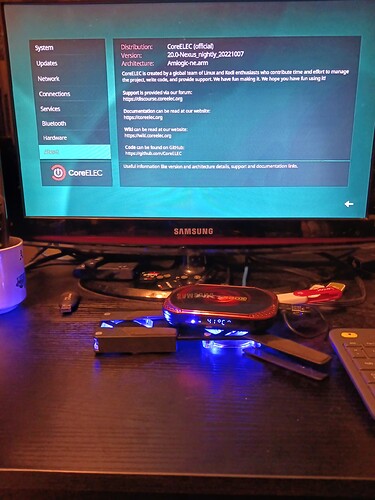http://ix.io/4cYb
Looking at this part of the log, ( dolby_vision_on=0 hdr_policy=1 hdr_priority= frac_rate_policy=1 hdmi_read_edid=1) does that mean my TV should show HDR?
It should have worked, maybe you ssh’d into another box?
Tried it again, and still came up with that error.
CoreELECHK1:~ # fw_printenv -n ethaddr
Error: “ethaddr” not defined
fw_printenv -n ethaddr
I swapped out my microSD card, with the 19.5 version and the original 192.168.10.6 is back.
Looking at your logs from the summer you have just been lucky Report about Amlogic S905X4 HK1 RBOX X4 - #254 by clarkss12
[ 0.590811@2]- eth%d: device MAC address 02:1f:00:00:00:00
What does all that mean? Without a MAC address, the IP can never be static?
You set a static IP in CoreElec. What the MAC does is give your router a “key” and it will try to assign you the same IP dynamically based on that if it can. Some routers allow you to make that assignment permanent but that is not exactly the same as static.
2 options:
- set the IP configuration on the CoreELEC device to manual and enter a static IP (including subnet mask, gateway and DNS servers), or
- bind a static IP to the device in the router, using the device’s MAC address.
Thank you for that information. So, once I set the IP address on my router, it will always show that IP, regardless of the MAC address??
The MAC address of your Ethernet Adapter is unique to the CE device. The router will assign (bind) a fixed IP to the MAC address, thus the CE device will always have the same IP address, regardless of the operating system or physical location within the LAN.
Usually, on a Local Area Network (LAN) with static IPs, routers are configured to exclude a range of IP addresses (ex: 192.168.0.10 - 192.168.0.50) from being assigned automatically. These IPs can then be manually assigned. This is to avoid IP conflict (when 2 different devices share the same IP on the same LAN).

Above is an example of what a MAC address looks like (00-1B-63-84-45-E6).
The trouble with these HK1 boxes and the JL2xxx chip is the MAC is not unique acccoring to CE rules. Initially I was getting the same MAC from two boxes and with ne I am finding it a bit more random, 02: and another random digit even on the same box. Hence the need to script it.
Each MAC address is unique to the network card installed on a device, but the number of device-identifying bits is limited, which means manufacturers do reuse them. Each manufacturer has about 1.68 million available addresses, so when it burns a device with a MAC address ending in FF-FF-FF, it starts again at 00-00-00. This approach assumes it is highly unlikely two devices with the same address will end up in the same local network segment.
No two devices on a local network should ever have the same MAC address. If that does happen, both devices will have communication problems because the local network will get confused about which device should receive the packet.
If your device is defying network standards, maybe you should have it replaced.
You have ethaddr=02:ad:32:01:cf:cc defined so the work around from @emveepee should work.
And yes, you got cheated as well, refurbished eMMc.
You can also try this solution:
Does anyone know if the eMMCs are soldered down or socketed?
I’ve ordered the Vontar X4 variant from their Aliexpress store and keeping my fingers crossed
Always soldered.
Good to know.
I knew the e in eMMC stood for embedded but the HardKernel Odroids have them on removable modules.
True, you can see this on SBC devices. But complete Android devices doesn’t use this approach.
Okay
I think iam finished with this ne and kernel 5.4
All is working except wifi
Have tried multiple times
With always failure
Maybe will try again
How to debug wifi in CoreELEC?
